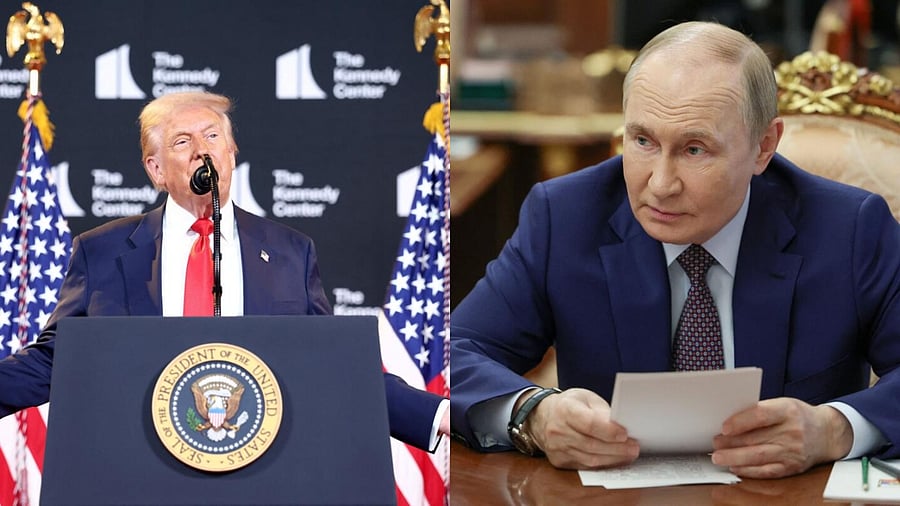
US President Donald Trump (L) and Russian President Vladimir Putin.
Credit: Reuters Photos
Notwithstanding hectic preparations, the first summit between the 47th United States President, Donald Trump, and his Russian counterpart, Vladimir Putin, must be watched for, if it actually takes place. Wait and see, if it is sabotaged even at this eleventh hour.
Kirill Dmitriev, who has the curious title of Putin’s envoy for investment, chose apt words when he said soon after the summit was announced on Friday that countries are making “titanic efforts” to make sure that it does not take place. “A number of countries interested in continuing the conflict will make titanic efforts to disrupt the planned meeting between President Putin and President Trump,” said Dmitriev, whose formal title is CEO of the Russian Direct Investment Fund.
Dmitriev is an insider both in Russia and in the US, which is rare. He studied at Stanford and went on to work for Goldman Sachs, when he forged friendships with some of the key members of Trump’s current team. So far, Dmitriev is the highest-ranking Kremlin insider to have travelled to the US since the war in Ukraine began three-and-a-half years ago.
The Joe Biden administration sanctioned him, so Trump had to procure a special exemption for Dmitriev to enter the US in April and meet Steve Witkoff, the presidential envoy who was instrumental in setting up the August 15 summit between Trump and Putin.
If history is the guide, secondary tariffs on purchasers of Russian oil could be paused or diluted if the Trump-Putin meeting is even a modest success. India will be a beneficiary.
Not many people today remember that it was Richard Nixon, the 37th US President, who first used tariffs as a weapon in diplomatic dealings. By the strangest of coincidences, precisely 54 years ago, on August 15, 1971, Nixon imposed a tariff of 10% on imports into the US, similar to Trump’s tariff strategy today.
The worst impact of Nixon’s unilateral tariff imposition was on Japan, which had not healed from its World War II devastation and relied heavily on exports to the US for its economic recovery. Emperor Hirohito arrived in Alaska six weeks later for the first-ever meeting between a Japanese monarch and a US president. It was also the first time a Japanese emperor had set foot on American soil. The Alaska meeting did not yield instant results, but by mid-December of 1971, the crippling import surcharge on Japan was gone.
It is another coincidence that Trump and Putin will also meet in Alaska, with tariffs and sanctions among the summit’s crowded agenda. Those who believe in the occult – and superstition is in surplus within the Trump family – may have considered Alaska as an auspicious venue for this summit. They may have concluded that the long-term success of this Friday’s summit is assured for this unnatural reason, even if the negotiations do not yield much immediately.
Russians live by their long history, unlike Americans, whose past spans just under 250 years since the Declaration of Independence in 1776. So, what could cross Putin’s mind when he arrives for the meeting with Trump? Friday’s summit has already spawned many stories on the history of Alaska, which belonged to Russia until 1867. Alaska’s Governor Mike Dunleavy, who will have a protocol presence surrounding the summit, is a Cold Warrior by accounts, and has previously raised the bogey of a Russian retrieval of the territory. More than this bit from Russia’s glorious past, Putin would not forget that Alaska became a springboard 41 years ago for ending the Cold War and the break-up of the Soviet Union.
John Paul II, the outspokenly anti-Communist Polish Pope, met then US President Ronald Reagan in Alaska in 1984. In that year, the US and the Holy See established formal diplomatic relations. Till then, their ties were informal and marked by a distinction between the Church and the State. This overtly political pope and the deeply anti-Kremlin Reagan forged an alliance that helped eventually to bring down the Berlin Wall and dissolve the Soviet Union. Putin’s Russia is now at the crossroads as its summit takes place with another US president, also in Alaska.
One fact is irrefutable. The Alaska summit is a victory for Russia’s steely president if only because it clearly ends what the West has been claiming as his isolation on the global stage. If the US and Russian presidents create the space for their bilateral ties to move forward, quarantined from Ukraine’s future, Putin would have rightfully earned Joseph Stalin’s trademark peaked cap with an Alaskan trophy gifted by Trump, a proverbial feather adorning it.
(K P Nayar has extensively covered West Asia and reported from Washington as a foreign correspondent for 15 years.)
Disclaimer: The views expressed above are the author's own. They do not necessarily reflect the views of DH.